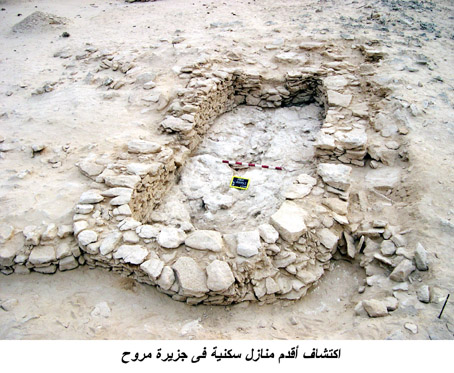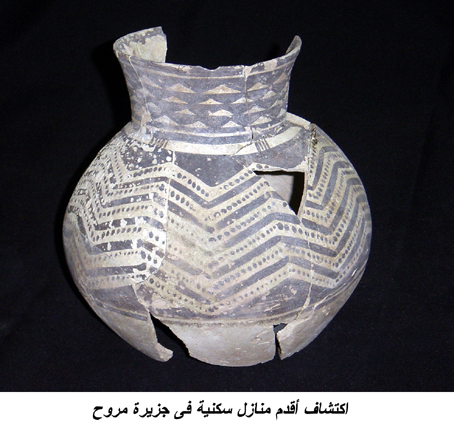
7000 year-old house at site MR11 on Marawah island

7000 year old house discovered at site MR11 on Marawah island

7000 year old pottery vessel discovered at site MR11 on Marawah island
Abu Dhabi Islands Archaeological Survey
Posted on 02/08/2005 4:40:08 PM PST by blam
Excavation unearths oldest archaeological site in UAE
By Prerna Suri
8 February 2005
DUBAI — The oldest archaeological site in the UAE dating back to 7,000 years, has been discovered on the island of Marawah, located about 100km west of Abu Dhabi, according to Dr Mark Beech, Senior Resident Archaeologist for the Abu Dhabi Islands Archaeological Survey (ADIAS).
Dr Beech disclosed the findings at a lecture organised by the Dubai Natural History Group which was attended by a large crowd.
The lecture covered important findings and discoveries by ADIAS during their excavation in 2004 including a skeleton of what is believed to be the earliest-known inhabitant of Abu Dhabi.
The excavations were carried out at the site of a 7,000 years old village in Marawah which has the best-preserved and most-sophisticated stone buildings of Neolithic date that are known anywhere in Eastern Arabia. Radiocarbon dates from the building, analysed last year, suggests that the upper layers inside date to between 6,500 to 7,000 years ago, indicating that the original construction may have been earlier.
"Work carried out in 2000 had initially suggested that a group of stone mounds located at the western end of the island, known as site MR11, was perhaps a church and Nestorian monastic complex," said Dr Beech.
"Excavations carried out at these sites in 2003 and 2004 subsequently proved that it was not a church or monastic complex but rather a series of major buildings forming an important Neolithic settlement. Radiocarbon dates as well as associated finds suggest that the settlement was established during the end of the first half of the sixth millennium BC, around 5700 cal BC making it the oldest site so far discovered in the UAE," he added.
Two of these structures have now been partly excavated revealing well-constructed buildings with stone walls still surviving to a height of almost a metre in some places.
"We also discovered traditional architecture dating to the pre-oil era such as wooden houses and fishermen boats which are very difficult to find these days. In addition, a dugong butchery middon which served as a source of food for inhabitants, dating since the past 200 year was also found," he said.
Dr Beech said that the discovery would underline the significance of Marawah as an area of importance for archaeologists in the region.
"The quite remarkable structures at site MR11 add to our growing knowledge of Neolithic building structures and settlements in SE Arabia," he said.
An almost complete pottery vessel of a type not previously found in South Eastern Arabia from the Neolithic Ubaid civilisation in southern Mesopotamia was also discovered on the island.
The pot, which is the most complete of its type and age ever found in the UAE, is also probably 6,500 to 7,000 years old, and provides evidence that the Neolithic inhabitants of Marawah were trading by sea with southern Mesopotamia.
PaleoPing
I believe the oldest pottery ever found comes from Japan.
How long till this gets blown up by a Jihadi ?
By the accounts of what has been excavated so far it sounds as though things haven't changed much throughout the Mid-East.
They did, however, find a Christmas fruitcake... still in its original wrapper.
Jomon - Oldest Pottery
First vessels in Incipient Jomon Period (12,700-10,000 B.P.), Japan
Starts as fiber-tempered
By Initial Jomon period (10,000-6000 B.P.), surfaces decorated with cord impressions or rouletting Generally thin-walled, small, conical (cooking?) pots Flamboyant shapes and decorations in Middle Jomon (4500-4000 B.P.)
Oldest Pottery Elsewhere
China, 11,000 B.P.: porous, thick-walled, grit-tempered plainware; cordmarked after 8000 B.P.
Africa, 9500 B.P.: sand/grit-tempered simple forms, some decorated with cord impressions or rocker stamping
Western Asia, 8300 B.P.: fine and coarse wares, some fiber-tempered; generally utilitarian
South America, ca. 7000 B.P., small sand-tempered bowls; fiber-tempered wares starting 6000 B.P.
Central America, 5000 B.P., influences from south (?); not in Mesomerican until after 3800 B.P.
North America, 4500 B.P., fiber-tempered basins and bowls in SE; much later in SW (2400 B.P.) and Midwest (2700 B.P.)
Jomon style cord-pottery has been found in Olmec sites in Mexico.
That stuff at the Pottery Barn looks pretty old to me. ;-)


7000 year old house discovered at site MR11 on Marawah island

7000 year old pottery vessel discovered at site MR11 on Marawah island
Abu Dhabi Islands Archaeological Survey
Now watch them dynamite the site of the dig because it was built by infidel pagans instead of Muslims.
Example of Jomon Cord marking

Please FREEPMAIL me if you want on, off, or alter the "Gods, Graves, Glyphs" PING list --
Archaeology/Anthropology/Ancient Cultures/Artifacts/Antiquities, etc.
The GGG Digest -- Gods, Graves, Glyphs (alpha order)
|
|
|||
Gods |
Just updating the GGG info, not sending a general distribution. |
||
|
· Discover · Nat Geographic · Texas AM Anthro News · Yahoo Anthro & Archaeo · Google · · The Archaeology Channel · Excerpt, or Link only? · cgk's list of ping lists · |
|||
Note: this topic is from 2/08/2005. Thanks blam and martin fierro.
Did they find a Death to America inscription?
No, instead, there was an ancient warning, “stay on their good side.”
Disclaimer: Opinions posted on Free Republic are those of the individual posters and do not necessarily represent the opinion of Free Republic or its management. All materials posted herein are protected by copyright law and the exemption for fair use of copyrighted works.